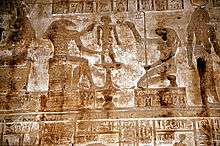Khnum
| Khnum | ||||
|---|---|---|---|---|
| God of creation and the waters | ||||
 the Egyptian god Khnum was usually depicted with the head of a ram. | ||||
| Name in hieroglyphs |
| |||
| Major cult center | Elephantine | |||
| Symbol | the potter's wheel | |||
| Consort | Satet, Neith, Heqet, Menchit, and Nebtu | |||
| Parents | Nun or Ra | |||
| Siblings | Neith | |||
| Offspring | Anuket, sometimes Serket, Heka or Ra, and Thoth | |||
Khnum (/kəˈnuːm/; also spelled Khnemu) was one of the earliest Egyptian deities, originally the god of the source of the Nile River. Since the annual flooding of the Nile brought with it silt and clay, and its water brought life to its surroundings, he was thought to be the creator of the bodies of human children, which he made at a potter's wheel, from clay, and placed in their mothers' wombs. He later was described as having moulded the other deities, and he had the titles Divine Potter and Lord of created things from himself.
General information
Khnum is the third aspect of Ra. He is the god of rebirth, creation and the evening sun, although this is usually the function of Atum. The worship of Khnum centered on two principal riverside sites, Elephantine Island and Esna, which were regarded as sacred sites. At Elephantine, he was worshipped alongside Anuket and Satet as the guardian of the source of the Nile River. His significance led to early theophoric names of him, for children, such as Khnum-Khufwy – Khnum is my Protector, the full name of Khufu, builder of the Great Pyramid.[1]
Khnum has also been related to the deity Min.[2]
Temple at Elephantine
The temple at Elephantine was dedicated to Khnum, his consort Satet and their daughter Anuket. The temple dates back to at least the Middle Kingdom. By the 11th dynasty Khnum, Satet and Anuket are all attested at Elephantine. During the New Kingdom finds from the time of Ramesses II show Khnum was still worshipped there.[3]
Opposite Elephantine, on the east bank at Aswan, Khnum, Satet and Anuket are shown on a chapel wall dating to the Ptolemaic time.[3]
Temple at Esna
%2C_N372.2.jpg)
In Esna (Latopolis), known as Iunyt or Ta-senet to the Ancient Egyptians, a temple was dedicated to Khnum, Neith and Heka, and other deities.[3] The temple dates to the Ptolemaic period. Khnum is sometimes depicted as a crocodile-headed god. Nebt-uu and Menhit are Khnum's principal consorts and Heka is his eldest son and successor. Both Khnum and Neith are referred to as creator deities in the texts at Esna. Khnum is sometimes referred to as the "father of the fathers" and Neith as the "mother of the mothers". They later become the parents of Re, who is also referred to as Khnum-Re.[4]
Other
The Beit el-Wali temple of Ramesses II contained statues of Khnum, Satis and Anukis, along with statues of Isis and Horus.[3]
In other locations, such as Herwer (Tuna el-Gebel perhaps), as the moulder and creator of the human body, he was sometimes regarded as the consort of Heket, or of Meskhenet, whose responsibility was breathing life into children at the moment of birth, as the Ka.
Artistic conventions
In art, he was usually depicted as a ram-headed man at a potter's wheel, with recently created children's bodies standing on the wheel, although he also appeared in his earlier guise as a water-god, holding a jar from which flowed a stream of water. However, he occasionally appeared in a compound image, depicting the elements, in which he, representing water, was shown as one of four heads of a man, with the others being, – Geb representing earth, Shu representing the air, and Osiris representing death.
References
| Wikimedia Commons has media related to Khnum. |
- ↑ Shaw, Ian. The Oxford History of Ancient Egypt. Oxford University Press. 2000. ISBN 0-19-280458-8
- ↑ Bechtel, F. (1907). "Ammon". The Catholic Encyclopedia. I. New York: Robert Appleton Company. Retrieved 2008-03-27.
- 1 2 3 4 Wilkinson, Richard H., The Complete Temples of Ancient Egypt, Thames and Hudson, 2000, ISBN 0-500-05100-3
- ↑ Kathryn Bard, Encyclopedia of the Archaeology of Ancient Egypt, Psychology Press, 1999
